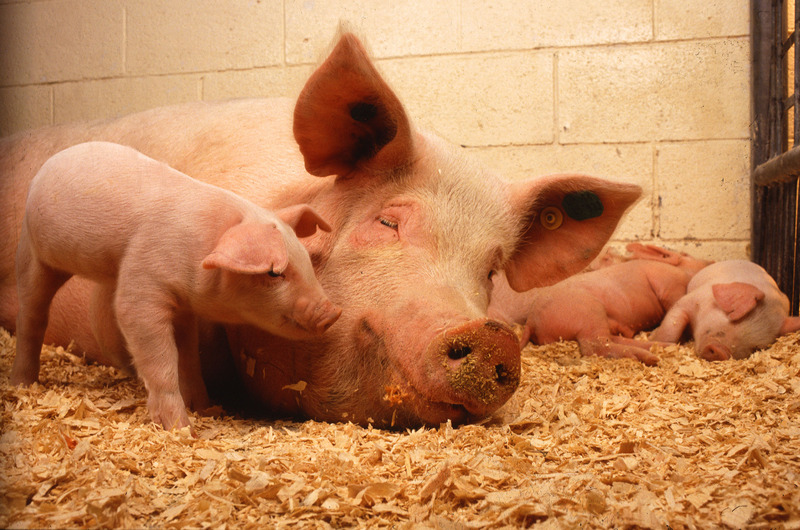Domestic Pig (Sus scrofa domestica) - Wiki Domestic pig
From Wikipedia, the free encyclopedia
[Photo] Domestic Pig (Sus scrofa domestica). Sow and five piglets from http://www.ars.usda.gov/is/graphics/photos/ Image Number K7974-18. This sow's five pigs developed from cryopreserved and surgically transferred embryos. Photo by Keith Weller.
Order: Artiodactyla
Family: Suidae
Genus: Sus
Trinomial name: Sus scrofa domestica Linnaeus, 1758
Synonyms: Sus domestica
The domestic pig (Sus scrofa domestica) is normally given the scientific name Sus scrofa, though some taxonomists use the term S. domestica, reserving S. scrofa for the wild boar. Pigs are believed to have been domesticated from wild boars as early as 7000 B.C. in the separately in China DNA evidence of semi-fossilized remains of teeth and jawbones of Neolithic pigs in Europe shows that migrating farmers brought their Near Eastern pigs with them. Modern European pigs are all descended, however, from European wild boar, showing that early European farmers soon domesticated pigs independently, from local wild stock, and the Near Eastern bloodlines entirely died out, domesticated European broodstock having then been exported in turn to the Ancient Near East. The adaptable nature and omnivorous diet of the Wild Boar allowed early humans to domesticate it much earlier than many other forms of livestock, such as cattle. Pigs were mostly used for food, but early civilizations also used the pigs' hides for shields, bones for tools and weapons, and bristles for brushes. Pigs were brought to southeastern North America from Europe by De Soto and other early Spanish explorer. Escaped pigs became feral and were used by Native Americans as food.
Modern pigs are found across Europe, and extend into Asia as far as Indonesia and Japan. The distinction between wild and domestic animals is slight. Most domestic pigs usually have rather sparse hair covering on their skin, but the woolly coated breeds are known and some were popular in the past. Escaped domestic pigs have become feral in many parts of the world (for example, New Zealand) and have caused substantial environmental damage.
Sus scrofa has four subspecies, each occupying distinct geographical areas:
Sus scrofa scrofa (western Africa, Europe)
Sus scrofa ussuricus (northern Asia and Japan)
Sus scrofa cristatus (Asia Minor, India)
Sus scrofa vittatus (Indonesia)
As food
The domestic pig is farmed for its meat called pork, which is obtained by slaughter. Products made of pork include sausage, bacon and ham. The head of a pig can be used to make head cheese. Liver, chitterlings, and other offal from pigs are also widely used for food. In some religions, such as Judaism and Islam, there are religious restrictions on the consumption of pork.
In industrialized nations, domestic pigs farming has shifted away from the traditional pig farm to large-scale intensive pig farms where meat can be mass-produced. This has resulted in lower production costs, but more significant animal welfare concerns.
Hog farmers refer to young female hogs who have borne less than two litters as gilts, female hogs who have borne more than two litters as sows, intact males as boars, castrated males as barrows, and young hogs of both sexes as pigs or piglets.
In developing nations, and some parts of developed nations, the domestic pig is frequently raised outdoors in yards. In some cases pigs are even raised in open fields where they are allowed to forage; they are watched by swineherds, the equivalent of shepherds for pigs.
As pets
Pigs are known to be intelligent animals and have been found to be more trainable than dogs or cats. Asian pot-bellied pigs, a smaller subspecies of the domestic pig, have made popular house pets in the United States beginning in the latter half of the 20th century. Regular domestic farmyard pigs have also been known to be kept indoors, but due to their large size and destructive tendencies, they typically need to be moved into an outdoor pen as they grow older. Most pigs also have an extreme fear of being picked up, but will usually calm down once placed back on the floor. Pigs are rarely used as working animals. An exception are the so-called truffle hogs used to find truffles.
Breeds of pigs
Pigs are exhibited at agricultural shows, judged either as stud stock compared to the standard features of each breed, or in commercial classes where the animals are judged primarily on their suitability for slaughter to provide premium meat.
List of domestic pig breeds
American guinea hog a rare breed of heritage popular with modern homesteaders
American Landrace
American Yorkshire
Angeln Saddleback
Arapawa Island
Ba Xuyen
Bantu
Bazna
Beijing Black
Belarus Black Pied
Belgian Landrace
Bentheim Black Pied
Berkshire
Black Slavonian
Black Canarian Pig
British Landrace
British Lop
Bulgarian White
Cantonese
Chester White
Czech Improved White
Danish Landrace
Dermantsi Pied
Duroc
Dutch Landrace
Fengjing
Finnish Landrance
French Landrace
German Landrace
Gloucestershire Old Spots
Grice
Guinea Hog
Hampshire
Hante
Hereford
Hezuo
Iberian
Italian Landrace
Jinhua
Kele
Jeju Black Pig
Krskopolje
Kunekune
Lacombe
Large Black
Large Black-white
Large White
Lithuanian Native
Leicoma
Mangalitsa
Meishan
Middle White
Minzhu
Mong Cai
Mukota
Mora Romagnola
Moura
Mulefoot
Neijiang
Ningxiang
Norwegian Landrace
Norwegian Yorkshire
Ossabaw Island
Oxford Sandy and Black
Philippine Native
Pi??train
Poland China
Red Wattle
Saddleback
Spots
Swabian-Hall
Swedish Landrace
Tamworth
Thuoc Nhieu
Tibetan
Tokyo-X
Turopolje
Vietnamese Potbelly
Welsh
Wessex Saddleback
West French White
Windsnyer
Wuzishan
Yanan
Zungo
Rare pig breeds
Woolly-coated grazing pig
http://en.wikipedia.org/wiki/Domestic_pig
| The text in this page is based on the copyrighted Wikipedia article shown in above URL. It is used under the GNU Free Documentation License. You may redistribute it, verbatim or modified, providing that you comply with the terms of the GFDL. |
